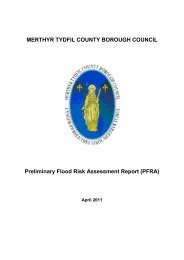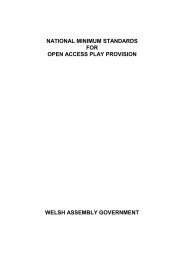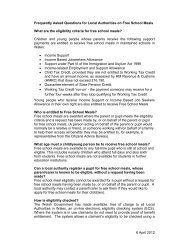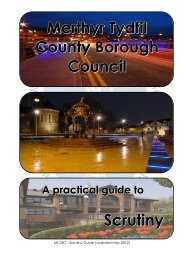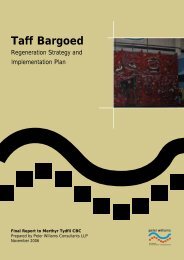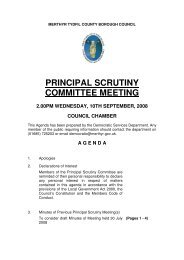SCHOOL ORGANISATION PLAN 2009-2014 - Merthyr Tydfil County ...
SCHOOL ORGANISATION PLAN 2009-2014 - Merthyr Tydfil County ...
SCHOOL ORGANISATION PLAN 2009-2014 - Merthyr Tydfil County ...
You also want an ePaper? Increase the reach of your titles
YUMPU automatically turns print PDFs into web optimized ePapers that Google loves.
Integrated Children’s Services<strong>SCHOOL</strong><strong>ORGANISATION</strong><strong>PLAN</strong><strong>2009</strong>-<strong>2014</strong>‘Putting children first……helping schools improve’Gosodplant yn Gyntaf…… yn helpu iwella ysgolion<strong>SCHOOL</strong> <strong>ORGANISATION</strong> <strong>PLAN</strong> <strong>2009</strong>-<strong>2014</strong>1
CONTENTS1.0 FOREWORD ................................................................................................................... 32.0 INTRODUCTIONPageNo(s)4-5<strong>Merthyr</strong> <strong>Tydfil</strong> <strong>County</strong> Borough Council – Vision …………………………………………….The Children’s and Young People’s Plan …………………………………………………….21 st Century Schools ......................................................................................................Supporting information in the School Organisation Plan .................................................3.0 EDUCATION SERVICE IN CONTEXTProfile of the <strong>County</strong> Borough ..........................................................................................Education Establishments................................................................................................What have we already achieved? ....................................................................................4.0 <strong>PLAN</strong>NING PRINCIPLESOverarching Purpose.......................................................................................................Planning school places ....................................................................................................Initiating Change..............................................................................................................Standards ........................................................................................................................Additional Learning Needs...............................................................................................Nursery and Primary School Provision.............................................................................Secondary School Provision ............................................................................................5.0 METHODOLOGYAdmission to schools .......................................................................................................Diversity of Provision .......................................................................................................Additional Learning Needs...............................................................................................Additional Learning Needs and Welsh Medium Education ...............................................Statistics relating to Pupils with Additional Learning Needs ............................................Community Schools.........................................................................................................Asset Management Plan..................................................................................................Welsh Education Scheme ……………………………………………………………………6.0 CONCLUSION AND PROPOSALSOptions for dealing with surplus places............................................................................Early Years and Foundation Phase..................................................................................Primary ............................................................................................................................Secondary .......................................................................................................................Additional Learning Needs...............................................................................................The Way Forward ………………………………………………………………………………..Proposals …………………………………………………………………………………………APPENDICESAppendix 1: MAP SHOWING LOCATION OF <strong>SCHOOL</strong>S AND EDUCATIONALESTABLISHMENTS ……………………………………………………………………………………44456-86679-1499101111121315-19161616181818191920-25202020212222222525<strong>SCHOOL</strong> <strong>ORGANISATION</strong> <strong>PLAN</strong> <strong>2009</strong>-<strong>2014</strong>2
1.0 FOREWORD1.1 In <strong>Merthyr</strong> <strong>Tydfil</strong>, our vision for education is shaped by national policies and by the localstrategic priorities identified by the <strong>County</strong> Borough Council and in the Community Strategy.The education service, which is part of the Integrated Children’s Service, aspires to excellencein all that it does, reflecting the local ambition for <strong>Merthyr</strong> <strong>Tydfil</strong> to become “a sustainable,confident <strong>County</strong> Borough which recognises and promotes equality of opportunity and wherepeople want to achieve in all aspects of their life, through work, leisure and learning.” (<strong>County</strong>Borough Council vision statement).1.2 Achieving our vision requires us to focus effectively on children and young people as a corecustomer group. This School Organisation Plan should be viewed as a key aspect of theAuthority’s Children and Young People’s Plan. The Authority is determined to fulfil its dutyeffectively in the planning of school places to give “added value” to the whole process ofdelivering quality education and will continue to strive to establish an improved educationinfrastructure, with the right number of schools of the right size in the most appropriatelocations. The Authority is clear about its wish to provide educational leadership through aparticular focus on school improvement and by continuing to forge strong partnerships withschools and other organisations that have an important contribution to make to “education forlife”. The Authority will continue to strike an appropriate balance between challenge andsupport, placing an emphasis on the celebration of success rather than focusing on failure.SignaturePortfolio Councillor for ICS/Lead Member for Children and Young PeopleSignaturePortfolio Councillor for ICS<strong>SCHOOL</strong> <strong>ORGANISATION</strong> <strong>PLAN</strong> <strong>2009</strong>-<strong>2014</strong>3
2.0 INTRODUCTION<strong>Merthyr</strong> <strong>Tydfil</strong> <strong>County</strong> Borough Council - Vision2.1 By 2010 <strong>Merthyr</strong> <strong>Tydfil</strong> will be a safe, healthy and exciting place to live. Our ambition is tobecome a sustainable, confident <strong>County</strong> Borough that recognises and promotes equality andwhere people want to achieve in all aspects of their life, through work, leisure and learning.The Children and Young People’s Plan2.2 The Children and Young People’s Plan is the overarching plan for children and young peoplein <strong>Merthyr</strong> <strong>Tydfil</strong> <strong>County</strong> Borough Council and so directly links with the Authority’s vision andrelated strategies and policies.2.3 The aim of the Children and Young People’s Plan is that every child and young person will:• have a flying start in life;• have a comprehensive range of education and learning opportunities;• enjoy the best possible health and are free from abuse, victimisation andexploitation;• have access to play, leisure, sporting and cultural activities;• are listened to, treated with respect and have their race and cultural identityrecognised;• have a safe home and a community which supports physical and emotionalwellbeing; and• not be disadvantaged by poverty.2.4 <strong>Merthyr</strong> <strong>Tydfil</strong> <strong>County</strong> Borough Council is working collaboratively with over 60 partnerorganisations to implement the Plan focusing on achieving a number of strategic priorities forchange relevant to children and young people of all ages are to improve:21st Century Schools• attainment, qualifications and life skills;• the social inclusion of disabled children and young people and their parents;• emotional and mental health of children and young people;• safety and well being for the most vulnerable children and young people;• health and well being of all children and young people, particularly the sexualhealth of young people;• children and young people’s enjoyment, learning and social skills and increasephysical activity through self directed play and recreational activity;• children’s, young people’s and their parents’ influence over the services theyreceive and over services which are designed for them;• homeless young people’s access to housing and support; and• the life chances of children and young people through alleviating the impact ofpoverty and disadvantage2.5 Jane Hutt, AM, the then Minister for Children, Education, Lifelong Learning and Skills,launched the Welsh Assembly Government’s 21 st Century Schools programme in July <strong>2009</strong>with details of a major funding package of £165m in capital investment for schools andcolleges in Wales. This is in addition to the £170 million investment that has already beenannounced by the Welsh Assembly Government over the last year.2.6 This additional funding will enable the delivery of a total capital investment programme ineducation that exceeds £530 million and is a key part of the Assembly Government’s OneWales commitment to deliver schools fit for purpose for the 21st century. This very significant<strong>SCHOOL</strong> <strong>ORGANISATION</strong> <strong>PLAN</strong> <strong>2009</strong>-<strong>2014</strong>4
investment will provide local authorities with the means to build new schools, improve schoolfacilities and develop purpose built Special Education Needs centres. Jane Hutt said:“The £165 million in capital investment will have a huge impact on our schools and FEIs,ensuring that our young people will be learning in educational facilities that are modern and fitfor purpose in the 21st Century. This specifically targeted capital investment will allow localauthorities and colleges to progress with their reorganisation programmes, creating learninginstitutions that inspire while helping fulfill one of our key One Wales objectives.”2.7 <strong>Merthyr</strong> <strong>Tydfil</strong> <strong>County</strong> Borough Council has already registered its interest in this programmewith the Welsh Assembly Government and plans strategically to improve the quality of all itseducational establishments through the School Organisation Plan, the Education AssetManagement Plan, and the Education Capital Programme.Supporting information in the School Organisation Plan2.8 The School Organisation Plan will support the above and provides information on:• forecasts of pupil numbers;• managing the supply of school places;• managing demand through admissions and appeals procedures; and• current strategic thinking about school places in <strong>Merthyr</strong> <strong>Tydfil</strong> <strong>County</strong> BoroughCouncil.<strong>SCHOOL</strong> <strong>ORGANISATION</strong> <strong>PLAN</strong> <strong>2009</strong>-<strong>2014</strong>5
3.0 EDUCATION SERVICE IN CONTEXTProfile of the <strong>County</strong> Borough3.1 The <strong>County</strong> Borough of <strong>Merthyr</strong> <strong>Tydfil</strong> is the smallest of the unitary authorities in Wales and ishome to approximately 56,000 (2001 census). <strong>Merthyr</strong> <strong>Tydfil</strong> has 18,500 children and youngpeople under age of 25. The proportion of children and young people is similar to the Welshaverage, but the total population is declining. The National Statistics 2006 mid-year estimatesshow <strong>Merthyr</strong> to be the only local authority in Wales with a declining population, with thebiggest decline since the 2001 Census. This is the result of a falling birth-rate and outwardmigration, while the population of Wales is increasing. Live births have fallen from 761 in 1995to 595 in 2002, but are now increasing. The population of primary school children will continueto fall until 2012; the 14 -19 population peaks in 2008 and will decline until 2017.3.2 Considerable efforts are currently being made to tackle the serious problems experienced in<strong>Merthyr</strong> <strong>Tydfil</strong> as one of the most disadvantaged communities in Wales. These efforts revolvearound a number of partnerships involving the <strong>County</strong> Borough Council working with bodiessuch as the Welsh Assembly Government, Heads of the Valley Board, <strong>Merthyr</strong> <strong>Tydfil</strong> College,University of Glamorgan, and a range of other organisations. Progress is being made butthere is still a range of issues to be addressed and resolved.Education Establishments3.3 In September <strong>2009</strong> there were thirty six educational establishments in the Local Authority,three nursery schools, twenty five infant, junior and primary schools (two on two sites), foursecondary schools (one located on two sites) one special school, two pupil referral units, andan Integrated Children’s Centre. The dates the school buildings were constructed are asfollows:-pre 1900 2 5.5%1900 – 1949 6 16.6%1950 – 1959 1 2.7%1960 – 1969 10 27.7%1970 – 1979 8 22.2%1980 – 1989 2 5.5%1990 – 1999 3 8.3%2000 – <strong>2009</strong> 4 11.1%3.4 The Authority has an aspirational capital building programme and plans, with continuedexternal funding support from the Welsh Assembly Government, to make all schools fit forteaching and learning in the 21 st Century by 2016. Since 1996 the Authority has built five neweducational establishments and refurbished two further schools. The latest school to open is a£6.2m Welsh-medium primary school, Ysgol Santes Tudful, and the Authority will completeanother two new primary schools by April 2010.3.5 By September 2010 the Authority will have replaced 17% of its educational buildings withbrand new innovatively designed buildings. These new buildings are having a positive impactupon pupil attainment and doing much to enable the aims of the Children and Young People’sPlan.<strong>SCHOOL</strong> <strong>ORGANISATION</strong> <strong>PLAN</strong> <strong>2009</strong>-<strong>2014</strong>6
3.6 The current educational buildings and the year built are as follows:<strong>SCHOOL</strong>YEAR BUILTNURSERYGurnos Nursery School 1977Trefechan Nursery School 1973Treharris Nursery School 1887PRIMARYAbercanaid Community School 2002Bedlinog Community Primary School Remodelled 1999Brecon Road Infants School 1902Caedraw Primary School 1962Cyfarthfa Junior School 1970Dowlais Primary School1969 (Junior) 1974 (Infant)Edwardsville Primary School 1974Gellifaelog Primary School 1996Goetre Junior School 1960Goetre Infants School 1960Gwaunfarren Primary School 1970Heolgerrig Community School 1906 (new school opening Spring 2010)Mount Pleasant Primary School 1912 (to close August 2010)Pantysgallog Primary School 1994St Aloysius RC Primary School 1968St Illtyd’s RC Primary School 1972St Mary’s RC Primary School 1963Trelewis Primary School 1984Troedyrhiw Primary School 1914, 1905 and remodelled 1971Twynyrodyn Community School 2004Ynysowen Community Primary1968 (new school under construction)SchoolYsgol Gynradd Coed y Dderwen 1958 & 1959Ysgol y Graig Primary 1932Ysgol Rhyd-y-Grug 1905Ysgol Santes Tudful <strong>2009</strong>SECONDARYAfon Taf High School 1967Bishop Hedley RC High School 1967Cyfarthfa High (Upper) School 1981 (Extended 2001)Cyfarthfa High (Lower) School 1825Pen-y-Dre High School 1972SPECIALGreenfield Special School 1968Pupil Referral Unit 1986Options Programme 1968Integrated Children’s Centre 2005WHAT HAVE WE ALREADY ACHIEVED?3.7 Effective planning of school places has ensured that <strong>Merthyr</strong> <strong>Tydfil</strong> <strong>County</strong> Borough Councilhas:• robust strategies for managing surplus places; since 2003 the Authority has reduced thecapacity of its schools by 13.2% (the removal of over 1,331 surplus places);• no school significantly overfull; the Authority has worked with schools to manageaccommodation needs and reduce the number of over capacity schools;<strong>SCHOOL</strong> <strong>ORGANISATION</strong> <strong>PLAN</strong> <strong>2009</strong>-<strong>2014</strong>7
• regular reviews of trends across the Authority informing school re-organisation proposalswhen appropriate;• developed community focused schools including the provision of community facilities in allnew schools; and• supported schools in maintaining class sizes at the statutory level.Since <strong>Merthyr</strong> <strong>Tydfil</strong> <strong>County</strong> Borough Council became a Local Authority in April 1996, thechanges to school places have included:-NURSERY/FOUNDATION PHASEPRIMARY• the provision of nursery education at St Aloysius, St Illtyd’s and St Mary’s R C primaryschools;• increase in nursery provision at Treharris Nursery School, Trelewis Primary School andYsgol Rhyd y Grug;• rebuilding of Treharris Nursery School following a major fire in March 2002;• the development of Foundation Phase facilities in ten schools; and• the closure of Ynysowen Nursery School to become part of Ynysowen Community PrimarySchool.• provision and completion of extensions at Caedraw Primary School, Pantysgallog PrimarySchool, Trelewis Primary School, Ysgol Rhyd y Grug, Ysgol Santes Tudful• the amalgamation of Gellideg Infant and Gellideg Junior Schools and formation of a newprimary school Ysgol Gynradd Coed y Dderwen (January 2002);• the closure of Pentrebach Infants School in August 2002;• the completed construction of a new and enlarged Abercanaid Community School(September 2002);• the amalgamation of Twynyrodyn Infants and Twynyrodyn Junior schools to form the newTwynyrodyn Community School from September 2003 and the transfer to the new schoolin January 2004;• the amalgamation of Edwardsville Infants School and Edwardsville Junior School to form anew primary school with effect from January 2005;• the closure of Bedlinog Infants, Bedlinog Junior and Graig Bedlinog Infants schools andthe opening of Bedlinog Primary School (in a remodelled Junior School, 2000);• the construction of the new Gellifaelog Primary School (1996);• the amalgamation of Troedyrhiw Junior and Troedyrhiw Infant schools to form a newprimary school with effect from September 2006;• the amalgamation of Dowlais Infant and Gwernllwyn Junior schools to form a new primaryschool with effect from September <strong>2009</strong>; and• the opening of the new Ysgol Santes Tudful, Welsh-medium Primary, February <strong>2009</strong>.SECONDARY• new extension at Cyfarthfa High School and new sports hall;• the closure of Vaynor and Penderyn High School with effect from September 2005; and• new sports barn at Bishop Hedley High School.OTHER• The opening of an Integrated Children’s Centre (2005)In total statutory proposals affecting 25 schools have been published, of which all weresuccessful.<strong>SCHOOL</strong> <strong>ORGANISATION</strong> <strong>PLAN</strong> <strong>2009</strong>-<strong>2014</strong>8
4.0 <strong>PLAN</strong>NING PRINCIPLESOverarching Purpose4.1 In planning the provision and supply of school places in <strong>Merthyr</strong> <strong>Tydfil</strong> <strong>County</strong> BoroughCouncil the Authority will seek to ensure an:• effective educational infrastructure in order that educational standards will continue to rise;• efficient provision and supply of school places and management of pupil admissions inorder that financial resources are spent to best effect.Planning school places4.2 The way the Authority plans its provision and supply of school places and manages theadmission of its pupils is crucial in ensuring that limited financial resources are spent to besteffect. Action is required to rationalise the provision of school places, largely because ofsignificant falling pupil rolls, movement in population, parental preferences and changes in thepattern of demand. Maintaining a higher than necessary level of school places ties upresources that could be better used to improve the quality of education.4.3 The Authority makes pupil number forecasts in order to assess the likely demand for schoolplaces. These projections are based upon a number of factors:• birth statistics provided by the local health authority;• information provided by schools;• number of pupils on roll and ages;• size and age composition of classes;• parental preferences and cross county movement of pupils;• transfer of pupils between primary and secondary schools and also between years 11 and12 within secondary schools;• location of private nurseries and playgroups;• information provided by other Council departments e.g. Planning; and• information on Welsh medium education provided by the headteachers of the two Welshmedium primary schools.Forecasts are currently available up until <strong>2014</strong> for primary schools and 2021 for secondaryschools.Schools operate most efficiently and effectively when full or nearly full. To this end theAuthority continues to prioritise the reduction of surplus places due to falling pupil rolls,movement in population, parental preferences and changes in the pattern of demand.Maintaining a higher than necessary level of school places ties up resources that could bebetter used to improve the quality of education. The Audit Commission defines schools with25% or more surplus accommodation as having “significant” over capacity. The AuditCommission suggests that local authorities should aim for individual school occupancy rateswithin the range of 85% - 105%.4.4 The Authority has responded to the continuing fall in pupil numbers by reducing the number ofsurplus places in schools. Since 2003 the Authority has removed 1,331 surplus places fromschools. This has been achieved through a planned programme of school closures andamalgamations, through replacement new build matched to identified need in all sectors andby working with schools and their communities to make best use of existing surplus capacity,for example for community focused learning.<strong>SCHOOL</strong> <strong>ORGANISATION</strong> <strong>PLAN</strong> <strong>2009</strong>-<strong>2014</strong>9
Surplus places35003000number of surplus places250020001500100020052007<strong>2009</strong>5000Primary sector Secondary sector Total surplus placesReduction in the number of surplus places across primary and secondary schools4.5 Strategic planning by the Authority ensures that there are sufficient places in accordance withparental preference, except where this would prejudice effective education and the efficientuse of resources. In conducting its duty to plan, the Authority takes account of overallchanges in demographic trends, local variations as a result of new housing developments orestates in decline and changing levels of popularity for particular schools.4.6 The Authority is committed to the inclusion of children with additional educational needs,where possible, in mainstream schools, unless there is a good, child centered reason why thechild should be placed in a special school.4.7 The main legislation and guidance regarding school organisation is:• School Standards and Framework Act 1998: Organisation of School Places• Education (School Organisation Proposals) (Wales) Regulations 1999 (as amended)• Change of Category of Maintained Schools (Wales) Regulations 2001 (as amended)• Education (Maintained Special Schools) (Wales) Regulations 1999• The National Assembly for Wales Circular 9/99• The National Assembly for Wales Circular 23/02 School Organisation Proposals• School Organisation Proposals by the National Assembly for Wales Regulations 2004• The National Assembly for Wales Circular 09/2006 Measuring the Capacity of Schools inWales• Welsh Assembly Government Circular 021/<strong>2009</strong> School organisation proposals.Initiating Change4.8 <strong>Merthyr</strong> <strong>Tydfil</strong> <strong>County</strong> Borough Council keeps school provision arrangements, pupil projectiondata, admission applications and the quality of teaching and learning in schools underconstant review.4.9 A variety of factors may lead the authority to make proposals for changes in school provision.These include:• school improvement opportunities;• significant surplus places;• curriculum changes which impact upon the accommodation requirements such asFoundation Phase, and the 14-19 Transforming Agenda.These factors may arise individually or in combination.<strong>SCHOOL</strong> <strong>ORGANISATION</strong> <strong>PLAN</strong> <strong>2009</strong>-<strong>2014</strong>10
4.10 School organisation proposals will be designed to ensure that the interests of existing pupilsare protected and advanced. Although this may cause short term difficulties and/or disruptionthe Authority is not afraid of making difficult decisions necessary to the long term interests of<strong>Merthyr</strong> <strong>Tydfil</strong> pupils.4.11 Prior to initiating any review or changes the Integrated Children’s Services department willmake such soundings and investigations as considered necessary to inform their report.4.12 The report will then be considered by Councillors who will either approve, or reject therecommendation to formally consult on the draft school organisation proposal.4.13 The consultation document will be published and will contain:• a clear statement outlining the reason for change;• one or more specific proposed changes; and• reasoning as to why the proposed change(s) represent the most appropriate way toaddress the stated reasons for change.The general aim will be that consultations are focused, precise and conducted to a managedtimescale of no more that necessary length. The purpose of this is to avoid long periods ofuncertainty and confusion.4.14 If appropriate, statutory notices and other processes outlined in the Education Acts will beadhered to. If necessary the proposal will be referred to the Minister for Children, Education,Lifelong Learning and Skills for determination.Standards4.15 Where a proposal includes any consideration of individual school quality or viability, particularfactors will be of relevance. These may include:• recent findings by HMI Estyn on the quality of the school;• popularity of the school will local residents and wider user groups;• prospects for the school remaining or becoming viable in terms of admissions; and• an indication that the school has a good understanding of the challenges it faces.Additional Learning Needs4.16 In planning provision for children with additional learning needs the Authority will:• ensure that suitable provision is available for all children and young people withadditional learning needs aged 2-25 years and for younger children where this isnecessary;• make such provision available in mainstream schools and Greenfield Special Schoolwhenever possible; and• <strong>Merthyr</strong> <strong>Tydfil</strong> <strong>County</strong> Borough Council has a successful team that works solely onplacing pupils with additional learning needs in mainstream settings. Overtime theAuthority aims to increase the proportion and number of children who can be offeredeffective and appropriate education in mainstream settings, principally be broadeningthe skills and special arrangements that can be made within the mainstream sector.<strong>SCHOOL</strong> <strong>ORGANISATION</strong> <strong>PLAN</strong> <strong>2009</strong>-<strong>2014</strong>11
Nursery and Primary School Provision4.17 As at September <strong>2009</strong>, <strong>Merthyr</strong> <strong>Tydfil</strong> <strong>County</strong> Borough Council has three nurseries, two infant,two junior and twenty-one primary schools.Of the primary schools, two are Welsh medium. In key stage 1 (pupils aged 5-7 years) themedium of instruction in these schools is wholly or mainly Welsh. In key stage 2 (pupils aged7-11 years), pupils are taught Welsh and English. There are also three voluntary aidedschools, financed largely by the Authority, but which are organised and run by the RomanCatholic Education Authority in partnership with the Authority.4.18 The Welsh Assembly Government has placed a statutory duty on local authorities to ensureclass sizes in the primary sector do not exceed 30 pupils (except under certain exceptions).Whilst decisions about the appropriate size of teaching groups are matters for individualgoverning bodies (primary class size legislation apart) and relate to:-• the key stage;• overall size of the school;• whether it is a mixed or single age class;• the management / organisational structures in place in the school;• the views of staff, governors and parents/carers; and• finance available.The Authority works closely with schools to support their efforts in maintaining class sizes atappropriate levels and in determining accommodation needs. The capacity of a school iscalculated using the Measuring the capacity of schools in Wales Guidance Information issuedby the Welsh Assembly Government.4.19 The number of pupils on roll and capacity of primary schools at January <strong>2009</strong>:SchoolAgeRangeNOR Jan09MCSWCapacitySurpluscapacityOvercapacitySurplus%Oversubscribed%Abercanaid Community 3 - 11 138 150 12 0 8.00 0.00Bedlinog Primary 3 - 11 103 120 17 0 14.17 0.00Brecon Road Infants 3 - 7 105 122 17 0 13.93 0.00Caedraw Primary l (w/o SENunit) 3 - 11 169 171 2 0 1.17 0.00Cyfarthfa Junior 7 - 11 174 166 0 8 0.00 4.82Dowlais Primary 3 - 11 165 210 45 0 21.43 0.00Edwardsville Primary 4 - 11 326 371 45 0 12.13 0.00Gellifaelog Primary 3 - 11 184 202 18 0 8.91 0.00Goetre Infants 4 - 7 133 177 44 0 24.86 0.00Goetre Junior 7 - 11 179 188 9 0 4.79 0.00Gwaunfarren Primary 3 - 11 238 264 26 0 9.85 0.00Heolgerrig Community 3 - 11 155 194 39 0 20.10 0.00Mount Pleasant 4 - 11 30 89 59 0 66.29 0.00Pantysgallog Primary 3 - 11 207 237 30 0 12.66 0.00St Aloysius R.C. Primary 3 - 11 144 157 13 0 8.28 0.00St Illtyd's R.C. Primary 3 - 11 142 141 0 1 0.00 0.71St Mary's R.C. Primary 3 - 11 168 188 20 0 10.64 0.00Trelewis Primary 3 - 11 182 210 28 0 13.33 0.00Troedyrhiw Primary 3 - 11 215 253 38 0 15.02 0.00Twynyrodyn Community 3 - 11 239 270 31 0 11.48 0.00Ynysowen CommunityPrimary 3 - 11 216 312 96 0 30.77 0.00Ysgol Gynradd Coed yDderwen 3 - 11 87 121 34 0 28.10 0.00Ysgol Rhyd y Grug 3 - 11 130 157 27 0 17.20 0.00Ysgol Santes Tudful 3 - 11 340 390 50 0 12.82 0.00Ysgol y Graig Primary 4 - 11 142 190 48 0 25.26 0.00(figures do not include nursery pupils orpupils with additional learning needs)4,311 5,050 748 9<strong>SCHOOL</strong> <strong>ORGANISATION</strong> <strong>PLAN</strong> <strong>2009</strong>-<strong>2014</strong>12
4.20 Whenever the Authority reviews primary school places it takes into account:• The size of the school. Schools below a particular size will have greater difficulty indelivering the national curriculum and in ensuring that staff develop specialised curriculumknowledge. Primary schools of between 60-90 pupils could be expected to experiencesuch difficulties.• The ethos of the school. Primary schools of between 300-500 pupils may need to makespecial arrangements to ensure that the schools continue to exude a caring ethos wherepupils are generally known by name to all or most teachers.• The continuum of curriculum experience. Primary schools with “all through” teaching forages 3-11 years are able to facilitate greater co-ordination between the Foundation Phaseand Key Stages 1 and 2 and offer more staff development opportunities. As a result theAuthority has tried to amalgamate nursery, infant and junior schools whenever appropriate.• The number of surplus places. The Authority critically reviews cases where schools havesignificant surplus places (more than 25%).Secondary School Provision4.21 There are four secondary schools all of which have provision for 11 to 18 year olds. One ofthe schools is a Roman Catholic voluntary aided school. All schools have post 16 provisioncatering for 614 pupils in January <strong>2009</strong>. A range of AS and A level courses are available aswell as the Welsh Baccalaureate and NVQ courses.There is no Welsh medium secondary school within the Authority. All pupils seeking aneducation via the medium of Welsh mainly attend Ysgol Gyfun Rhydywaun, Cynon Valley inRhondda Cynon Taff. In January <strong>2009</strong> 404 pupils who reside in <strong>Merthyr</strong> <strong>Tydfil</strong> attendedschool at Ysgol Gyfun Rhydywaun.4.22 The number of pupils on roll and capacity of secondary schools at January <strong>2009</strong>:School NameAgeRangeNOR atJanuary<strong>2009</strong>MCSWCapacitySurplusCapacitySurplus%Afon Taf High 11 - 18+ 1,098 1,458 360 24.69Bishop Hedley R.C.314 32.34High 11 - 18+ 657 971Cyfarthfa High 11 - 18+ 1449 1,465 16 1.09Pen- y- dre High 11 - 18+ 882 1,159 277 23.904,086 5,053 967 19.144.23 In January <strong>2009</strong> the number of pupils in the secondary schools ranged from 657 to 1,449, withall schools having surplus places. Overall surplus accommodation accounts for approximately19.14% of total accommodation available with three schools showing significant unfilledplaces.Possible options for dealing with surplus places in secondary schools are being considered.The options are not firm models or proposals but, rather, help exemplify possible issues forattention in planning for change. Given the evolving nature of proposals for post-16 educationand training in <strong>Merthyr</strong> <strong>Tydfil</strong>, it is necessary at this stage to consider the issues in relation toboth 11-18 schools and, subject to any change of age range, 11-16 schools. Only when thefuture of post-16 education in <strong>Merthyr</strong> <strong>Tydfil</strong> has been resolved will it be possible to move tofirm proposals for any secondary school reorganisation. The nature of the proposals and theirpotential for improving the overall quality of educational provision across the 11-16 age rangeas well as post-16 is dependent on the availability of sufficient capital to deliver the desiredchanges.<strong>SCHOOL</strong> <strong>ORGANISATION</strong> <strong>PLAN</strong> <strong>2009</strong>-<strong>2014</strong>13
4.24 In reviewing secondary school provision, greatest attention will need to focus on the post 16curriculum. Students should enjoy a range and quality of post 16 educational provision which:• gives equality of access to both breadth and depth of study through a learning entitlementto a variety of courses which can be taken in different combinations;• leads to a wide and appropriate range of opportunity post 18, either in higher or furthereducation, or the world of work;• provides continuity in the experience of learning;• is conducive to learning in a structured and supportive educational community;• is responsive to the needs of, and supported by, the local community;• draws upon a high level of teacher expertise;• has access to a good range and quality of material resources;• provides effectively for those parents who wish their children to be educated in adenominational setting;• is efficient and sustainable over the longer term; and• results in a high degree of examination success as well as securing students’ personal andsocial development.<strong>SCHOOL</strong> <strong>ORGANISATION</strong> <strong>PLAN</strong> <strong>2009</strong>-<strong>2014</strong>14
5. METHODOLOGY5.1 Planning of school places is based upon probabilities not certainties and while projections maybe derived from sound calculations they come without guarantees. Nonetheless, theAuthority’s calculations are robust and are often the best in Wales for accuracy (ADEWBenchmarking data) and provide a sound basis for pupil projection data.5.2 In recent years the demographic changes in <strong>Merthyr</strong> <strong>Tydfil</strong> have affected the pupil numbers atschools and during the period January 1996 to January <strong>2009</strong> there has been a net loss of18.94% of pupils across all sectors (a loss of 2,221 pupils).5.3 For many years the primary sector has seen a continual fall in pupil numbers and whilst thereis evidence that the number of pupils in primary schools is starting stabilising, the earlier fall innumbers is now affecting secondary schools and will continue to do so for most of the nextdecade. In the period January <strong>2009</strong> – January <strong>2014</strong> the number of secondary schools pupilsis expected to drop by 533.5.4 This fall in pupil population is expected to continue in the immediate future. Details ofanticipated numbers are given below.Primary SchoolsActualNOR atJan <strong>2009</strong>ForecastNOR at Jan2010ForecastNOR atJan2011ForecastNOR atJan 2012ForecastNOR atJan 2013ForecastNOR atJan <strong>2014</strong>Abercanaid Community School 138 150 178 195 202 202Bedlinog Primary School 103 95 101 106 115 112Brecon Road Infants School 105 112 101 100 99 101Caedraw Primary School (w/o SENunit) 169 175 166 176 175 171Cyfarthfa Junior School 174 161 159 149 141 144Dowlais Primary School wef Sept <strong>2009</strong> 165 166 169 172 175 172Edwardsville Primary School 326 336 330 340 356 362Gellifaelog Primary School 184 188 175 175 178 183Goetre Infants School 133 160 178 191 194 189Goetre Junior School 179 180 168 164 187 207Gwaunfarren Primary School 238 239 240 227 235 229Heolgerrig Community School 155 162 167 169 175 195Mount Pleasant Primary School 30 28 Closed Closed Closed ClosedPantysgallog Primary School 207 194 206 203 199 200St Aloysius R.C. Primary School 144 147 152 153 162 166St Illtyd's R.C. Primary School 142 141 139 139 150 143St Mary's R.C. Primary School 168 166 166 169 165 166Trelewis Primary School 182 192 191 188 188 194Troedyrhiw Primary 215 215 216 217 221 215Twynyrodyn Community School 239 234 232 231 241 237Ynysowen Community Primary School 216 200 226 217 213 218Ysgol Gynradd Coed y Dderwen 87 100 103 105 109 117Ysgol Rhyd y Grug 130 126 123 129 135 149Ysgol Santes Tudful 340 350 358 365 379 397Ysgol y Graig Primary 142 145 152 156 161 172Total 4,474 4,362 4,396 4,436 4,555 4,641<strong>SCHOOL</strong> <strong>ORGANISATION</strong> <strong>PLAN</strong> <strong>2009</strong>-<strong>2014</strong>15
Secondary SchoolActualNOR atJan <strong>2009</strong>ForecastNOR atJan 2010ForecastNOR atJan 2011ForecastNOR atJan 2012ForecastNOR atJan 2013ForecastNOR atJan <strong>2014</strong>Admission to SchoolsAfon Taf High 1,098 1080 1,029 988 940 898Bishop Hedley R.C.650 641 624 604 591High 657Cyfarthfa High 1,4491406 1,378 1,373 1,357 1,324Pen- y- Dre High 882 833 781 762 727 710Total 4,086 3,969 3,829 3,747 3,628 3,5235.5 Every school has an area it traditionally serves known as a catchment area. Mostparents/carers send their children to the ‘local’ school, but some parents exercise their right tostate a preference for a different school. Due to the number of pupils on roll in our schools inalmost all cases these preferences are able to be met. Indeed there has been no appealagainst an admission refusal to attend a maintained school since the early 1990’s.Full details of the Authority’s admission policy and procedures are contained in its annualpublication “A Guide to Policy and Admission Arrangements”. The Authority’s policy andpractice in dealing with the admission process complies with Welsh Assembly Guidance“School Admissions Code, Circular 002/<strong>2009</strong> – July <strong>2009</strong>”.Diversity of Provision5.6 Within the <strong>County</strong> Borough there is there is a mixed ‘economy’ of provision for 3 year oldsboth in terms and types of providers – local authority maintained nursery schools and nurseryclasses, playgroups and private nurseries, and also in the extent of provision whether it is fullor part time.There is presently no demand within the Authority for separate gender schools or for Church inWales primary or secondary schools. Provision for Roman Catholic education exists in theform of three primary schools (each with nursery classes and one secondary school. Withregard to Welsh medium education, children are able to attend one of five Clychoedd Meithrinrun by Mudiad Ysgolion Meithrin and there are two primary schools (each with nurseryclasses). Welsh medium pupils generally continue their education at Ysgol Gyfun Rhydywaunwithin Rhondda Cynon Taff Authority.Additional Learning Needs5.7 Provision for pupils with additional learning needs is an important part of the educationservice. It is estimated that 20% of pupils in England and Wales will have additional learningneeds at some time during their school career. Some of these needs may respond quickly toappropriate provision; others may be long lasting and require special provision throughout theeducational careers of the children/young people concerned. Approximately 2% of childrenmay require a statement of special educational needs.5.8 The Authority recognises its duty to identify a child who may have an additional learning needif s/he:• has a significantly greater difficulty in learning than the majority of children of the sameage; and/or• has a disability which either prevents or hinders him/her from making use of theeducational facilities generally provided for children of his/her age in schools within thearea of the Authority.5.9 The Authority enables pupils with additional learning needs to be educated in local schoolswhere possible and desirable, provided this takes into account parental/carer views, and iscompatible with:<strong>SCHOOL</strong> <strong>ORGANISATION</strong> <strong>PLAN</strong> <strong>2009</strong>-<strong>2014</strong>16
• his/her receiving the special educational provision which his/her learning difficulty calls for;• the provision of efficient education for the children with whom s/he will be educated; and• the efficient use of resources.The Authority works closely through the Additional Learning Needs Team, the Health Authorityand Property Services Division to ensure that wherever possible school buildings are adaptedto meet the needs of individual pupils.5.10 For all pupils with additional learning needs a variety of options for provision are consideredand the vast majority will have their needs met within a mainstream class in their school. Thefacilities available for those pupils who require additional support to meet their needs include:• observation classes in infant/primary schools for pupils aged 3-7 years with a range ofdevelopmental delays and requiring ongoing assessment;• special classes in junior/primary schools for pupils aged 7-11 years with a range oflearning difficulties;• unit for pupils aged 3-11 years with speech and language difficulties based in amainstream school;• unit for pupils aged 3-11 years with physical/motor impairment, complex difficulties basedin a mainstream school;• unit for pupils aged 3-11 years with hearing impairment/communication difficulties based ina mainstream school;• unit for secondary aged pupils with hearing impairment, speech and language difficultiesand for ambulant pupils with physical/motor impairment based in a mainstream school;• additional learning needs department in each secondary school to meet the needs ofpupils with learning difficulties;• The Authority has one special school (Greenfield Special School) which caters for up to147 children with moderate and severe learning difficulties; behavioural difficulties;profound and multiple learning difficulties; and difficulties related to autism;• Pupil Referral Unit caters for approximately 16 pupils with emotional and behaviouraldifficulties. The main aim of the Unit is to reintegrate children to mainstream schooling.Each child is on roll in a mainstream secondary school;• Options Programme for years 10 and 11 pupils showing signs of disaffection or difficultbehaviour;• out of county borough placements for a small number of pupils who require specialistprovision that cannot be adequately met from the services available within the Authority;and• provision for gifted and talented pupils is available in all our schools. Most pupils who areparticularly gifted or talented will make good progress with simple enhancements to theirtimetables and programmes of study. Advice to parents/cares and teachers of able pupilsis available through the Educational and Child Psychology Service.Additional Learning Needs and Welsh Medium Education<strong>SCHOOL</strong> <strong>ORGANISATION</strong> <strong>PLAN</strong> <strong>2009</strong>-<strong>2014</strong>17
5.11 The Authority has regard for the Special Educational Needs Code of Practice for Wales andseeks to meet the additional learning needs of all of its pupils, including those pupils who arebilingual and/or studying in the medium of Welsh.5.12 Where a pupil has significant learning difficulties, requiring placement in a special school, theAuthority undertakes an assessment under the 1996 Education Act to determine the pupil’slevel of need. Where communication is a major part of the pupil’s learning difficulties,alternative communication systems are recommended e.g. signing, Makaton, and these wouldbe made available in Welsh and English. All pupils in the special school follow the nationalcurriculum throughout and would therefore receive Welsh language teaching.5.13 Where a pupil has significant behaviour difficulties, requiring placement in the Pupil ReferralUnit, the pupil would attend on a part time basis only, thus ensuring his or her continuedteaching through the Welsh medium in his/her mainstream school.5.14 Where a pupil is excluded from school and requires home tuition, or where home tuition isprovided on medical grounds, the materials for teaching a child at home are provided throughthe school which the child has attended. If the child has attended a Welsh medium school,therefore, he/she would have access to the same materials as he/she had in school. Anumber of home tutors are able to teach through the medium of Welsh.5.15 Welsh medium schools have a favourable weighting for language support, a resource madeavailable to identified individuals. The Authority also funds dyslexia support from aneighbouring authority to support <strong>Merthyr</strong> <strong>Tydfil</strong> pupils already at Ysgol Gyfun Rhydywaun.Statistics Relating to Pupils with Additional Learning Needs5.16 Special classes in schools (January <strong>2009</strong>)SchoolNo ofspecialclassesDescriptionNumber ofpupils inspecialclassAbercanaid Community Primary 1 Observation 9Caedraw Primary 2 Physical disability/complex 16difficultiesEdwardsville Primary 1 Moderate learning difficulties 15Goetre Infant 2 Observation 16Goetre Junior 3 Moderate to severe learning 34difficultiesGwernllwyn Junior [Primary] 1 Moderate learning difficulties 12Twynyrodyn Community 1 Moderate learning difficulties 12Ynysowen Community Primary 3 Moderate learning difficulties20Communication hearing impairedSpeech and LanguageYsgol y Graig Primary 1 Moderate learning difficulties 14Afon Taf High School 1 Hearing Unit 12Community Schools5.17 The Authority regards its schools as community assets and recognises that they can play amajor role in developing and supporting communities and addressing issues related to socialinclusion. The Community Focused Schools team works closely with schools and hasdeveloped additional accommodation for community provision at two primary schools as wellas assisting all schools in enabling greater community involvement.5.18 All new school builds include community facilities and the Authority works closely with schoolswith surplus capacity to enable refurbishment of facilities specifically for community use,whenever possible. The Authority currently has 29% of schools with dedicated facilities for thecommunity.<strong>SCHOOL</strong> <strong>ORGANISATION</strong> <strong>PLAN</strong> <strong>2009</strong>-<strong>2014</strong>18
• all pupils, through the Curriculum Cymreig, are given opportunities in their study to developand apply their knowledge and understanding of the culture, economic, environmental,historical and linguistic characteristics of Wales; and• the continuity and progression in the learning and teaching of Welsh from one key stage toanother.A copy of the draft Welsh Education Scheme is available from the Integrated Children’sServices department and on the website at www.merthyr.gov.uk.6.0 CONCLUSIONS AND PROPOSALS6.1 This section examines the key areas for action over the next five academic years and sets outbroad proposals. A recurring theme is the need to concentrate resources (funding, expertise,support) on equality of opportunity, the removal of surplus places from both the primary andsecondary phases of education and improve the schools and building stock and their facilities.The primary sector has experienced significant falling rolls for some years and this is nowaffecting secondary education. A high priority of the Authority must be to remove surplusaccommodation where it is envisaged that it will no longer be required. Forward planning is akey feature in managing the education building stock especially with regard to pupil numberforecasts and their accuracy.Options for dealing with surplus places6.2 Options for dealing with surplus places include proposals for school closures, amalgamationsand new or upgraded school buildings matched appropriately in size to the anticipated pupilpopulation. Other possible options include:• increasing the use of surplus places for community or youth facilities;• redesignating catchment areas, which can be controversial and, given the policy ofparental choice, is not binding;• amending the capacity of the school downward because of school site issues, forexample split site accommodation can reduce the capacity by up to 10% of the physicalcapacity of the school. Where appropriate this has already been applied within therevised capacity calculations, with the approval of the Welsh Assembly Government; and• removing certain classrooms from school use. This is only used for health and safetyreasons.Early Years and Foundation Phase6.3 There is universal provision for all ‘rising five’ year olds (reception aged children) in theAuthority. With regard to three to four year olds (nursery aged pupils) it is estimated that inexcess of 96% receive education at an Authority maintained school, although some attend ona part-time basis only. This meets the Welsh Assembly Government’s requirement that everychild be statutorily entitled to receive three terms of nursery education prior to the start ofcompulsory education (i.e. the start of the term following a child’s fifth birthday).Primary6.4 The Authority has had much success in reducing the number of surplus places in the primarysector and working with schools and governing bodies will maintain this drive over the nextfive year period.6.5 The latest school organisation project (Spring – Summer <strong>2009</strong>) approved is the amalgamationof Dowlais Infant School and Gwernllwyn Junior School and this took effect from 1 st<strong>SCHOOL</strong> <strong>ORGANISATION</strong> <strong>PLAN</strong> <strong>2009</strong>-<strong>2014</strong>20
September, <strong>2009</strong>. During the Autumn-Spring Term <strong>2009</strong>-2010 the Authority will consult on theamalgamation of Goetre Junior and Infant schools.6.6 Subject to the availability of the necessary funds, the Integrated Children’s Services isrequested to maintain the drive on school reorganisation, aimed at reducing surplus places,improving the overall quality of school buildings and enhancing the quality of educationalprovision.Secondary6.7 Although there is currently just over 19% surplus accommodation across the secondary sector(i.e. 967 places) the projected fall in pupil numbers will see the total figure for the secondarysector at over 25% surplus places by 2020. It is appropriate, therefore, to consider the needfor further secondary school reorganisation to reduce surplus places.6.8 Any proposals for secondary school reorganisation in <strong>Merthyr</strong> <strong>Tydfil</strong> are linked inextricably toproposals to reorganise post-16 provision. In particular, should the ‘character’/age range of thesecondary schools change as a consequence of losing their sixth forms, this would have theeffect of increasing the number of surplus places in the schools (by over 500). The impact ofthis would be to require a different set of solutions for secondary reorganisation than wouldotherwise be the case. For example, the need for school closure or amalgamation may beheightened whilst the need for new build may be reduced as a consequence of more spacebecoming available in each school to accommodate increased numbers of 11 to 16-year-oldsfollowing any amalgamations or closures. In general, in order to plan effectively for anyproposed reorganisation of our secondary schools, it is necessary to await the outcomes ofpresent discussions and possible consultation and proposals about the future of post-16education and training in <strong>Merthyr</strong> <strong>Tydfil</strong>.6.9 Notwithstanding the challenges associated with progressing secondary school reorganisationpresently, it is imperative to recognise the need for change and to commence planning forthose aspects of provision that, subject to the availability of adequate financial resources andthe outcomes of consultation, can be managed in the short to medium term as part of astaggered approach to organising school places.6.10 Various options for dealing with surplus places in secondary schools are being considered.The options are not firm models or proposals, but rather help exemplify possible issues forattention in planning for change. Given the evolving nature of proposals for post-16 educationand training in <strong>Merthyr</strong> <strong>Tydfil</strong>, it is necessary at this stage to consider the issues in relation toboth 11-18 schools and, subject to any change of age range, 11-16 schools. Only when thefuture of post-16 education in <strong>Merthyr</strong> <strong>Tydfil</strong> has been resolved will it be possible to move tofirm proposals for secondary school reorganisation. The nature of the proposals and theirpotential for improving the overall quality of educational provision across the 11-16 age rangeas well as post-16 is heavily dependent on the availability of sufficient capital to deliver thedesired changes.6.11 Subject to the availability of the necessary funds, the Integrated Children’s Services willmaintain the drive on school reorganisation, aimed at reducing surplus places, improving theoverall quality of school buildings and enhancing the quality of educational provision.<strong>SCHOOL</strong> <strong>ORGANISATION</strong> <strong>PLAN</strong> <strong>2009</strong>-<strong>2014</strong>21
Additional Learning Needs6.12 The Authority is continually reviewing its provision for pupils with additional learning needs toensure that it adds value. The role and remit of the special school, special classes inmainstream schools and all specialist services are constantly evolving and their effectivenessin meeting the needs of pupils continues to be evaluated. Alongside these developments runsthe programme of professional development for special educational needs staff therebyenabling schools to meet special educational needs from within their own resources.6.13 The role of the special school is crucial in promoting wider opportunities for inclusion inpartnership with mainstream schools and Unlocking the potential of Greenfield Special Schoolis part of this strategy.6.14 Every effort will be made to ensure that the additional learning needs of pupils in <strong>Merthyr</strong> <strong>Tydfil</strong>are met in a consistent and coherent way offering a continuum of provision to meet acontinuum of need.6.15 Promote inclusion through a variety of initiatives involving both special and mainstreamschools. During <strong>2009</strong>-2010 this will involve an appraisal of the PRU and Options facilities witha view to improving accommodation, educational opportunities and links with schools.The Way Forward6.16 The Authority’s statutory responsibility for the planning and provision of school places is aparticularly complex one and any proposed change to existing provision is likely to be emotive.However, rationalisation of school provision on a strategically planned basis would:-• ensure that schools retained are strengthened both in educational and financial terms;• yield financial savings on a significant scale which could be ploughed back into theschools’ sector;• remove surplus places from the system; and• strengthen the educational system.Proposals6.17 A summary of the local authority’s proposals are given overleaf.<strong>SCHOOL</strong> <strong>ORGANISATION</strong> <strong>PLAN</strong> <strong>2009</strong>-<strong>2014</strong>22
SUMMARY OF PROPOSALSSector Key Issue Proposals TargetAll Surplus placessectorsAllsectorsAllsectorsAllsectorsAllsectorsExpansion ofCommunity FocusedSchoolsAccessibilitySchool BuildingImprovementProgrammeWelsh mediumeducationTo reduce surplus places byworking with schools and aprogramme of review andrationalisation of school placesTo work with schools,governing bodies andCommunity Focused SchoolsTeam to promote greater useof school buildings by thecommunityTo work with schools,Additional Learning NeedsTeam, Health Authority,Property Services and parentsto ensure schools areaccessible to meet the needsof individual pupils withmobility problemsTo progress priorities ofEducation Asset ManagementPlan to ensure all schoolssuitable for teaching andlearning in the 21 st CenturyTo progress priorities of WelshEducation SchemePrimary reduce surplusplaces by 10% (75places) by 2011.Secondary reduce surplusplaces by 5% (49 places)by 2012 and a further 500places between 2012 and2015Open new communityfacilities at TwynyrodynCommunity School (2010).Provide new communityfacilities at HeolgerrigCommunity (<strong>2009</strong>) andYnysowen CommunityPrimary (2010)100% pupils with additionalphysical needs are able toattend the school of theirpreferenceAll schools fit for purposeby end of 2015<strong>2009</strong> - <strong>2014</strong>AllsectorsSurplus temporaryaccommodationTo remove terrapin classes nolonger used by schoolsBy <strong>2014</strong>EarlyYears/FoundationPhaseEarlyYears/FoundationPhasePrimaryTo ensureaccommodation needsof Foundation Phase areprovided in allmaintained schools.To enable Flying Startand other pre schoolgroups to have accessto schoolaccommodationwhenever possibleAmalgamation ofGwernllwyn Junior andDowlais Infant SchoolsTo work with schools and theEarly Years’ Team to targetcapital funding appropriately.To work with schools and theChildren and Young People’sPartnership to determinewhere capacity is availableand where appropriate bringforward proposals accordinglyImplementation of approvedschool organisation project<strong>2009</strong> – <strong>2014</strong><strong>2009</strong>-<strong>2014</strong>With effect from 1 stSeptember, <strong>2009</strong><strong>SCHOOL</strong> <strong>ORGANISATION</strong> <strong>PLAN</strong> <strong>2009</strong>-<strong>2014</strong>23
PrimaryPrimaryAmalgamation of GoetreJunior and InfantSchoolsClosure of MountPleasant Primary Schooland amalgamation withYnysowen CommunityPrimary SchoolConsultation on proposal toamalgamate Goetre Juniorand Infant schools and ifconsidered appropriate bringforward proposalsImplementation of approvedschool organisation project.Work with school to enabletransfer to new school site for2010-11 academic yearSpring Term 2010By 31 st August 2010<strong>SCHOOL</strong> <strong>ORGANISATION</strong> <strong>PLAN</strong> <strong>2009</strong>-<strong>2014</strong>24
Sector Key Issue Proposals TargetSecondaryPupils aged14-19Post 16ProvisionReview ofsecondaryeducationprovisionSplit sitesecondary schoolProvision ofWelsh mediumsecondaryeducationTransformingAgenda<strong>Merthyr</strong> LearningQuarter (MLQ)To continue the review ofsecondary education asapproved by Council June<strong>2009</strong>Take forward options tolocate Cyfarthfa High School(Lower site) on Upper Schoolsite. Phased arrangements tocommence Autumn 2010Maintain co-operativearrangements with RhonddaCynon Taff <strong>County</strong> BoroughCouncil regarding theprovision of Welsh mediumsecondary education for<strong>Merthyr</strong> <strong>Tydfil</strong> pupilsContinue to progressarrangements in line withpriorities of ANDPTo work with ProgrammeBoard to progress MLQComplete the review bySummer 2010Single school site by<strong>2014</strong><strong>2009</strong> – ongoing.<strong>2009</strong>-<strong>2014</strong><strong>2009</strong>-ongoingSpecialEducationGeneralInclusionPupil numberforecastingmethodologyAssetManagementPlan <strong>2009</strong>-<strong>2014</strong>Capital BuildingProgramme <strong>2009</strong>-2010To promote inclusionthroughout a variety ofinitiatives involving bothspecial and mainstreamschoolsTo critically examine themethodology in forecastingpupil numbers and undertakean evaluation of pastestimatesTo ensure the improvementsidentified in the AssetManagement Plan arefinanced and implemented inaccordance with the identifiedtimescalesTo ensure that the capitalbuilding programme isfinanced and implemented inaccordance with the identifiedtimescales<strong>2009</strong>-ongoingSummer <strong>2009</strong><strong>2009</strong> - ongoing<strong>2009</strong> - ongoing<strong>SCHOOL</strong> <strong>ORGANISATION</strong> <strong>PLAN</strong> <strong>2009</strong>-<strong>2014</strong>25
MAP SHOWING LOCATION OF <strong>SCHOOL</strong>S ANDEDUCATIONAL ESTABLISHMENTSAppendix 1<strong>SCHOOL</strong> <strong>ORGANISATION</strong> <strong>PLAN</strong> <strong>2009</strong>-<strong>2014</strong>26



